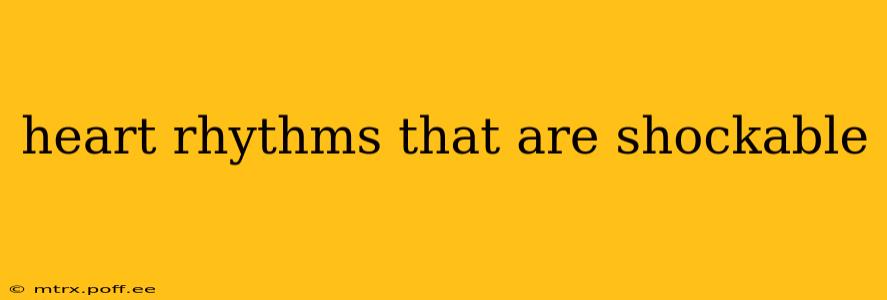Sudden cardiac arrest (SCA) is a life-threatening emergency where the heart suddenly stops beating effectively. Defibrillation, a process using an electric shock to restart the heart, is a critical intervention in these situations. However, defibrillation is only effective for specific heart rhythms. This article will explore the shockable heart rhythms, emphasizing the importance of rapid recognition and intervention.
What is Defibrillation?
Defibrillation uses a controlled electrical shock to interrupt the chaotic electrical activity causing the heart to fibrillate (quiver ineffectively) and allow it to resume a normal rhythm. It's a crucial part of cardiopulmonary resuscitation (CPR) and is most effective when administered quickly after cardiac arrest. Improper use can be dangerous, so it should only be performed by trained medical professionals or individuals using automated external defibrillators (AEDs).
Shockable Heart Rhythms: Ventricular Fibrillation (VF) and Pulseless Ventricular Tachycardia (pVT)
The two main shockable rhythms are:
1. Ventricular Fibrillation (VF): This is a chaotic, disorganized rhythm where the ventricles (the lower chambers of the heart) quiver instead of contracting effectively. There's no organized heartbeat, resulting in no blood flow to the body. VF appears on an electrocardiogram (ECG) as a wavy, irregular line with no discernible P waves, QRS complexes, or T waves. It's the most common rhythm encountered in SCA.
2. Pulseless Ventricular Tachycardia (pVT): In pVT, the ventricles beat very rapidly (usually over 100 beats per minute) but in an ineffective manner. This rapid rate prevents the heart from filling properly, leading to inadequate blood flow and eventually cardiac arrest. On an ECG, pVT shows rapid, wide QRS complexes without discernible P waves. The key distinction between pVT and VT with a pulse is the absence of a palpable pulse in pVT.
What are the differences between VF and pVT?
While both VF and pVT are life-threatening and require defibrillation, there are key differences:
- Appearance on ECG: VF appears as a chaotic, irregular waveform, whereas pVT shows rapid, wide QRS complexes.
- Heart activity: In VF, the ventricles are quivering; in pVT, they are beating rapidly but ineffectively.
- Treatment: Both require immediate defibrillation and CPR.
Unshockable Rhythms: Why Some Rhythms Don't Respond to Defibrillation
It's crucial to understand that not all cardiac arrest rhythms respond to defibrillation. Some rhythms, such as pulseless electrical activity (PEA) and asystole (flatline), require different interventions focused on addressing the underlying cause of cardiac arrest. These rhythms lack organized electrical activity that can be reset with a shock. Immediate CPR and advanced life support measures are crucial in these situations.
What are some examples of nonshockable rhythms?
Pulseless electrical activity (PEA) and asystole (flatline) are examples of nonshockable rhythms that don't respond to defibrillation. These require different treatment strategies focusing on addressing the underlying cause of the cardiac arrest.
How to Recognize Shockable Rhythms: The Role of AEDs and ECGs
Recognizing shockable rhythms requires specialized training and the use of electrocardiograms (ECGs) or automated external defibrillators (AEDs). AEDs analyze the heart rhythm and advise whether a shock is necessary. Trained professionals interpret ECGs to determine the appropriate treatment.
What are the limitations of AEDs?
While AEDs are invaluable in emergency situations, they have limitations. They might not be accurate in all cases and should always be used in conjunction with CPR.
The Importance of Early Defibrillation: Time is Crucial
Early defibrillation significantly increases the chances of survival after sudden cardiac arrest. Every minute without defibrillation decreases the chances of survival. Immediate CPR and access to a defibrillator are critical for improving outcomes.
What are the chances of survival after sudden cardiac arrest?
Survival rates after SCA vary based on several factors, including the speed of intervention, the underlying cause, and the availability of appropriate treatment. Early defibrillation drastically improves survival odds.
In conclusion, understanding which heart rhythms are shockable is vital for effective treatment of sudden cardiac arrest. Ventricular fibrillation and pulseless ventricular tachycardia are the primary shockable rhythms. Prompt recognition, CPR, and defibrillation are crucial for maximizing the chances of survival. Remember, timely intervention is key, and training in CPR and the use of AEDs is essential for anyone who wants to be prepared to respond to such emergencies.
